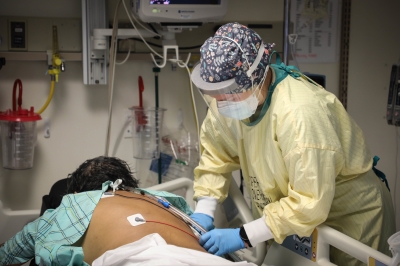
Navy Lt. Codi Kelly, a critical care nurse with the Rural Rapid Response Team, cares for a patient while working in the COVID-19 ward at the Northern Navajo Medical Center in Shiprock, NM, late last year. Lack of infrastructure was one of the factors that has put Native American health at risk during the COVID-19 pandemic. Army photo by Spc. Ashunteia Smith
WASHINGTON — The COVID-19 pandemic, which disproportionately affected Native Americans, has revealed a critical need for investments in those communities, according to trial advocates and the Indian Health Service (IHS).
That includes housing, sanitation, clean water and broadband. The pandemic has also highlighted the age of many IHS facilities, which were not easily adapted to care for patients during the worst of the outbreaks.
Statistics from the national Centers for Disease Control and Prevention, American Indian and Alaska Native (AI/AN) populations had a higher percentage of COVID-19-related hospitalizations and deaths than any other ethnic group. AI/AN people are 1.6 times more likely to contract COVID-19 than non-Hispanic whites, 3.5 times more likely to be hospitalized and 2.4 times more likely to die from the virus. The CDC partially attributes this to long-recognized health disparities: AI/AN people have higher rates of diabetes, obesity, smoking and cardiovascular conditions.
Those health disparities and the increased vulnerability to COVID-19 might be linked to larger infrastructure problems, however. For example, according to IHS, nearly half of Native communities in the United States do not have access to reliable water sources, clean drinking water or basic sanitation.
Testifying before the Senate Indian Affairs Committee last month, IHS Chief Medical Officer Michael Toedt, MD, told legislators that access to clean water was a critical concern for the agency over the last year. As part of its pandemic response, IHS deployed nine teams of Public Health Service Commissioned Corps Officers in support of the Navajo nation to improve access to safe water points. This included surveying the availability of water points across 27,00 square miles and eventually identifying 59 locations where additional water points were needed. Installation of those water points took six months to complete.
Broadband Access
Another pressing need, Toedt pointed out, is a lack of broadband access in rural Native communities, as well as deficiencies in IHS’s own IT architecture. “The pandemic highlighted the challenges and risks of our current IT architecture, which created significant barriers to the rapid response needed for COVID-19,” he explained. “In terms of telehealth, we’ve had successes by expanding our vidoeconferencing system and were able to see more patients. But the vast majority of our telehealth visits were by telephone rather than video. And that’s because of that last mile. The person on the other end doesn’t necessarily have the bandwidth capability to do a telehealth visit.”
Robert Onders, MD, administrator of the Alaska Native Medical Center in Anchorage, described similar barriers with rural Alaska Native communities.
“What we saw in COVID is that there’s a great opportunity for extending access to telehealth,” Onders said. “Remote Alaskan villages rely on 2G connectivity. So the ability to potentially deliver home service requires that investment in broadband.”
The broadband also needs to be affordable, he added. The same broadband service that costs $80 in Anchorage can run up to $400 in Nome, making it unaffordable for the average citizen.
The pandemic also put a strain on IHS’s aging facilities, which made it difficult to pivot to socially distanced care, Toedt said.
“Our facilities were built many years ago. The average age is 37 years. Some are much older,” he told the committee. “And these older facilities [are difficult to adapt to new] standards for infection control, patient flow, separation of patients, waiting areas and so forth. We need to invest in our facilities in order to make the changes necessary in order to be prepared for future pandemics.”
The American Rescue Plan Act, signed into law in March, contains $6.1 billion for IHS, Urban Indian and Tribal health programs. Much of that funding is directed specifically at vaccine rollout, infection monitoring and COVID-19 tracing activities. However, $140 million is dedicated to IT and $600 million is dedicated to renovating facilities to make them better able to respond to COVID-19.
The hearing also touched on the mental health aftermath of the pandemic. With the pandemic’s negative impact on housing and employment and the extreme disruption of family life, some advocates are expecting a growing need for mental health services, which would further increase the need for telehealth.
“Mental health is a growing tsunami waiting to happen,” declared Sheri-Ann Daniels, EdD, Executive Director of Papa Ola Lokahi, a healthcare advocacy group for Native Hawaiians.
“We’re still in this phase of [reacting to] COVID. We haven’t even lifted our heads up to plan ahead,” she explained “That’s going to be the real test. How are we going to start planting seeds now so we can deal with the mental health wave, not just the COVID wave, moving forward. How do we start messaging to our communities about seeking support. … For a lot of our communities, the need to look somebody in the eye to help them navigate through this, is going to be very critical. [This is] in many cases counter to [social distancing] guidance. Telehealth is an amazing opportunity, but how do we teach our communities how to use it?”


